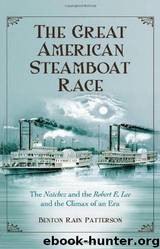The Great American Steamboat Race by Benton Rain Patterson

Author:Benton Rain Patterson [Patterson, Benton Rain]
Language: eng
Format: epub, mobi
Tags: History, Sports
ISBN: 9780786442928
Google: 78bq2MKZhwIC
Amazon: 0786442921
Barnesnoble: 0786442921
Publisher: McFarland
Published: 2009-05-01T10:00:00+00:00
•9• The Hard-Working Life
William Wells Brown was born into slavery in Lexington, Kentucky, in 1814 and when he was in his twenties, he worked aboard the Mississippi River steamboats Missouri, Enterprize and Chester, and on the Missouri River steamer Otto for a while. In 1847, after fleeing to freedom in Ohio and later having found a home in Boston, he wrote his autobiography, giving glimpses of life on the Mississippi as he saw it.
Brown was the son of a white plantation owner and a black slave woman and was sold as a child to a relative of his father. He moved with his new master from Kentucky to Missouri and was hired out to a Major Freeland, who in turn hired him out to work aboard the steamer Missouri, which ran between St. Louis and Galena, Illinois. In his book, a slender volume titled The Narrative of William W. Brown, a Fugitive Slave, Brown calls that steamboat assignment “the most pleasant time for me that I had ever experienced.” He later was hired out to the captain of the Enterprize to work as a waiter. “My employment on board,” he wrote, “was to wait on gentlemen, and the captain being a good man, the situation was a pleasant one to me — but in passing from place to place, and seeing new faces every day, and knowing they could go where they pleased, I soon became unhappy, and several times thought of leaving the boat at some landing place and trying to make my escape to Canada.”
Although he apparently received little or no ill treatment himself while working as a waiter, he got a close look at how other slaves were treated and the conditions in which they were hopelessly trapped. It was the cargoes of fellow slaves that bothered him most. “On our downward passage,” he recalled, “the boat took on board, at Hannibal, a drove of slaves, bound for the New Orleans market. They numbered from fifty to sixty, consisting of men and women from eighteen to forty years of age. A drove of slaves on a southern steamboat, bound for the cotton or sugar regions, is an occurrence so com
117
mon that no one, not even the passengers, appear to notice it, though they clank their chains at every step. “There was on the boat a large room on the lower deck,” Brown wrote, “in which the slaves were kept, men and women, promiscuously — all chained two and two, and a strict watch kept that they did not get loose; for cases have occurred in which slaves have got off their chains, and made their escape at landing-places, while the boats were taking in wood — and with all our care, we lost one woman who had been taken from her husband and children and having no desire to live without them, in the agony of her soul jumped overboard and drowned herself. She was not chained.” The part of the boat where the slaves were kept,
Download
The Great American Steamboat Race by Benton Rain Patterson.mobi
This site does not store any files on its server. We only index and link to content provided by other sites. Please contact the content providers to delete copyright contents if any and email us, we'll remove relevant links or contents immediately.
| Automotive | Engineering |
| Transportation |
Small Unmanned Fixed-wing Aircraft Design by Andrew J. Keane Andras Sobester James P. Scanlan & András Sóbester & James P. Scanlan(32685)
Navigation and Map Reading by K Andrew(4963)
Endurance: Shackleton's Incredible Voyage by Alfred Lansing(4629)
And the Band Played On by Randy Shilts(2082)
Wild Ride by Adam Lashinsky(1901)
Top 10 Prague (EYEWITNESS TOP 10 TRAVEL GUIDES) by DK(1899)
The Box by Marc Levinson(1898)
The Race for Hitler's X-Planes: Britain's 1945 Mission to Capture Secret Luftwaffe Technology by John Christopher(1766)
The One Percenter Encyclopedia by Bill Hayes(1754)
Trans-Siberian Railway by Lonely Planet(1664)
Girls Auto Clinic Glove Box Guide by Patrice Banks(1654)
Looking for a Ship by John McPhee(1608)
Batavia's Graveyard by Mike Dash(1585)
TWA 800 by Jack Cashill(1564)
Fighting Hitler's Jets: The Extraordinary Story of the American Airmen Who Beat the Luftwaffe and Defeated Nazi Germany by Robert F. Dorr(1544)
Good with Words by Patrick Barry(1540)
Troubleshooting and Repair of Diesel Engines by Paul Dempsey(1531)
Ticket to Ride by Tom Chesshyre(1522)
Bligh by Rob Mundle(1519)
